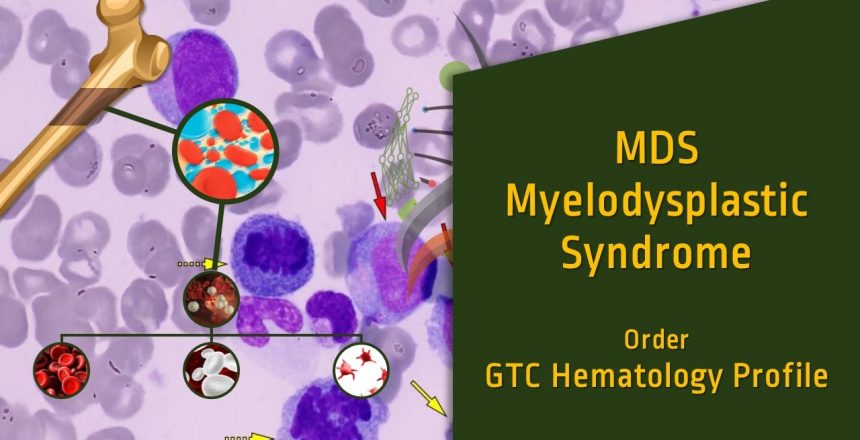MDS is defined as ineffective hematopoiesis characterized by adequate or increased hematologic elements in bone marrow with peripheral cytopenia. Therefore, the presence of cytopenia in one or more hematologic lines is necessary for the diagnosis of MDS. However, numerous reactive conditions other than MDS can cause cytopenia and these conditions must be distinguished from MDS. While dysplasia in hematologic cells is an indication of the diagnosis of MDS, the presence of mutations along with cytopenia is the most conclusive evidence for the diagnosis of MDS.
Normal individuals above the age of 50 may show mutation in some genes (ASXL1, TET2, DNMT3, and TP53), however, the level (Variant allele frequency, VAF) is low (<10%). If there is no evidence of cytopenia, the presence of mutation is called clonal hematopoiesis of indeterminate potential (CHIP) and in the presence of cytopenia, it is called Clonal cytopenia of undetermined significance (CCUS). Patients with CHIP may develop hematologic neoplasms at later time and patients with CCUS most likely will develop overt neoplasm within 5 years. Developing overt MDS increases significantly if the VAF is above 10%.
Practically, cytopenia with a mutation between 10% and 20% should be considered early MDS. In the presence of mutations in two or more genes and VAF >10%, diagnosis of MDS can be made. Mutation in FLT3 and NPM1 should be considered an indication of acute myeloid leukemia, which can be de novo or secondary. Below are the most commonly mutated genes in MDS based on our database:
TET2
Frequency: 31%
Prognosis: Neutral
Action: Hypomethylating agents, Vitamin C may activate TET2 function.
Most of TET2 mutations lead to termination and loss of function and expression. Loss of function in TET2 leads to DNA hypermethylation and silencing the expression of important genes.
DNMT3A
Frequency: 28%
Prognosis: Poor
Action: Hypomethylating agents
Mutations in DNMT3A lead to significant hypermethylation.
ASXL1
Frequency: 21%
Prognosis: Poor
Action: bromodomain and extraterminal (BET) Inhibitors
ASXL1 gen is involved in chromatin modification. ASXL1 mutations can be gain of function or truncation and perhaps loss of function. lead to loss of function and significant hypermethylation.
SRSF2
Frequency: 17%
Prognosis: Poor
Action: Spliceosome modifiers (H3B-8800, sudemycins, spliceostatin A, and meayamycin)
SRSF2 gene is involved in RNA splicing.
SF3B1
Frequency: 1 5%
Prognosis: Favorable
Action: Spliceosome modifiers (H3B-8800, sudemycins, spliceostatin A, and meayamycin)
SF3B1 gene is involved in RNA splicing and almost always associated with ring sideroblasts. When detected with JAK2, CALR or MPL, MDS/MPN-RARS-T should be considered.
RUNX1
Frequency: 11%
Prognosis: Poor
Action: RUNX1 Inhibitors
RUNX1 is a transcription factor, also called core-binding factor subunit alpha-2 (CBFA2).
TP53
Frequency: 10%
Prognosis: Poor
Action: ” MDM2 inhibitors, Hypomethylation agents, Wee1 inhibitors, Chk1 inhibitors, kevetrin, APR-246, nutlins, gene therapy”
TP53 mutations imply defect checkpoint/cell cycle mechanism and indicate very aggressive disease.
NRAS
Frequency: 8%
Prognosis: Poor
Action: MEK Inhibitors
Presence of NRAS mutation is an indication of monocytic lineage involvement and chronic myelomonocytic (CMML) disease rather than pure MDS.
U2AF1
Frequency: 6%
Prognosis: Poor
Action: Spliceosome modifiers (H3B-8800, sudemycins, spliceostatin A, and meayamycin)
U2AF1 is involved in RNA splicing
IDH2
Frequency: 5%
Prognosis: Neutral
Action: IDH2 inhibitors
IDH2 is involved in DNA methylation
JAK2
Frequency: 5%
Prognosis: Neutral
Action: JAK2 inhibitors ( ruxolitinib, fedratinib, Pacritinib, Momelotinib)
JAK2 is involved as a tyrosine kinase involved in cytokine pathway. The presence of JAK2 mutation in MDS should always raise the possibility of MPN/MDS with ring sideroblasts and thrombocytosis.
SETBP1
Frequency: 5%
Prognosis: Poor
Action: No targeted therapy
SETBP1 protein is a nuclear oncoprotein forms a complex involved in cell proliferation.
ZRSR2
Frequency: 5%
Prognosis: Poor
Action: Spliceosome modifiers (H3B-8800, sudemycins, spliceostatin A, and meayamycin)
ZRSR2 is located on X chromosome and more frequently mutated in males.
CBL
Frequency: 4%
Prognosis: Poor
Action: No targeted therapy
CBL protein is E3 ubiquitin ligase involved in RAS pathway, therefore, more commonly mutated in CMML.
IDH1
Frequency: 4%
Prognosis: Neutral
Action: IDH1 inhibitors
IDH1 mutations lead to hypermethylation.
Specimen Requirements:
-Liquid Biopsy:
5 mL. Peripheral blood in EDTA tube.
-Bone Marrow Cells:
2 mL. EDTA tube.
-Peripheral Blood Cells:
5 mL. EDTA tube.
-FFPE:
1 H&E slide and 6-8 unstained slides, 5-7 microns of BM clot or tissue
Shipping:
Ship using cold pack. The cold pack should not directly contact Blood or BM specimen. Ship As soon as sample collected with overnight delivery.
Turn Around Time:
5-7 days


